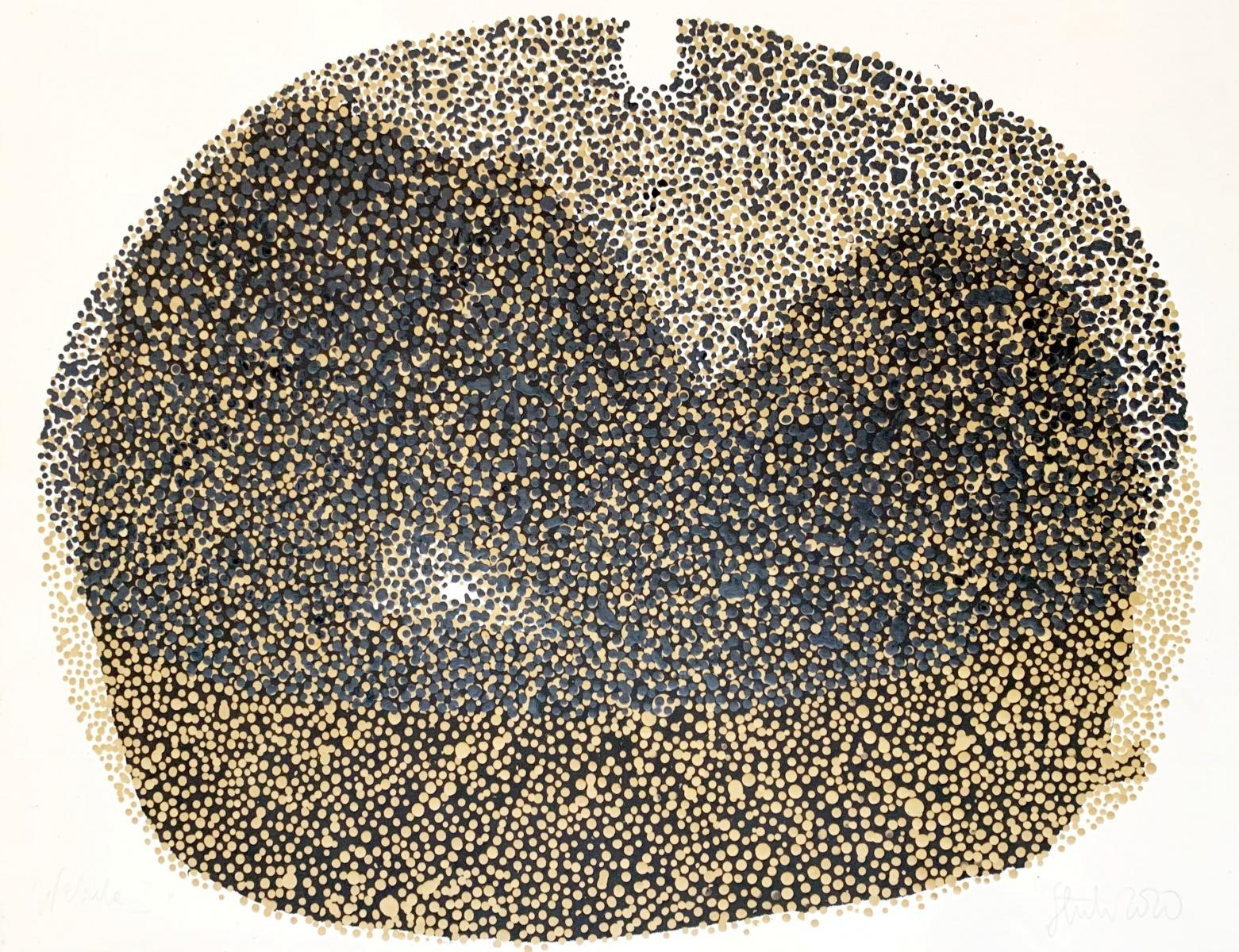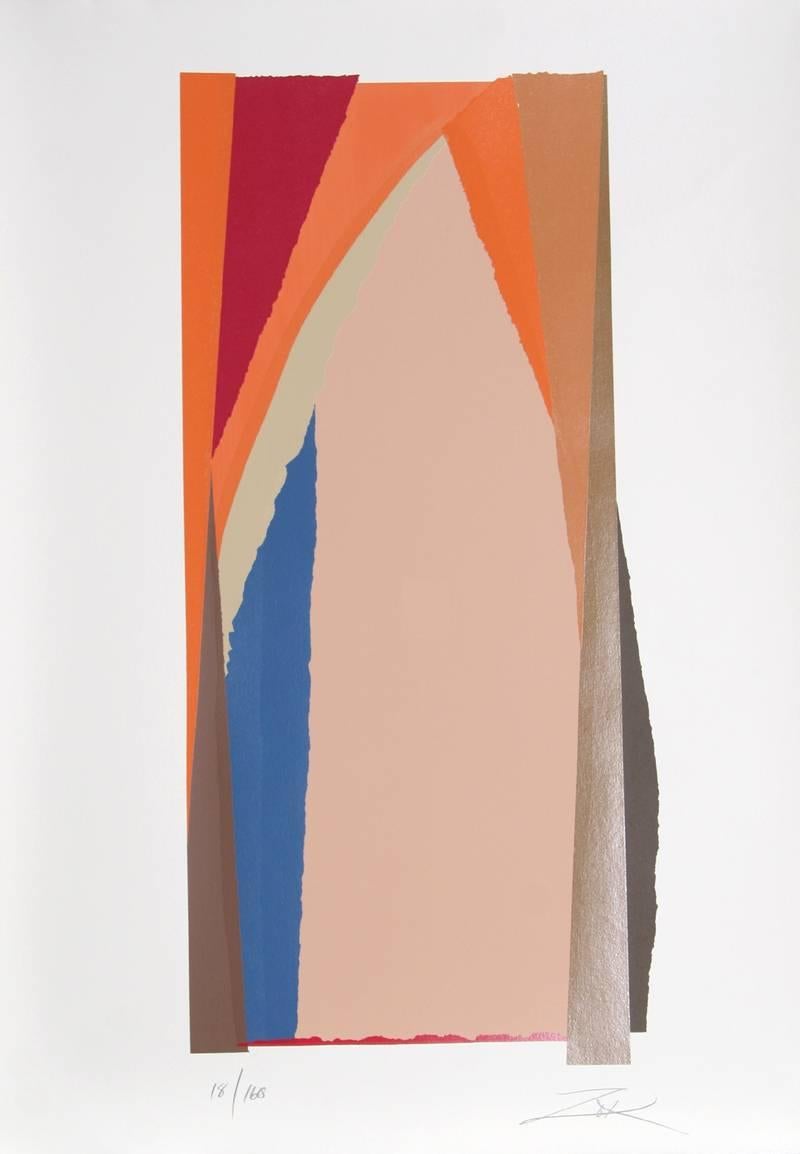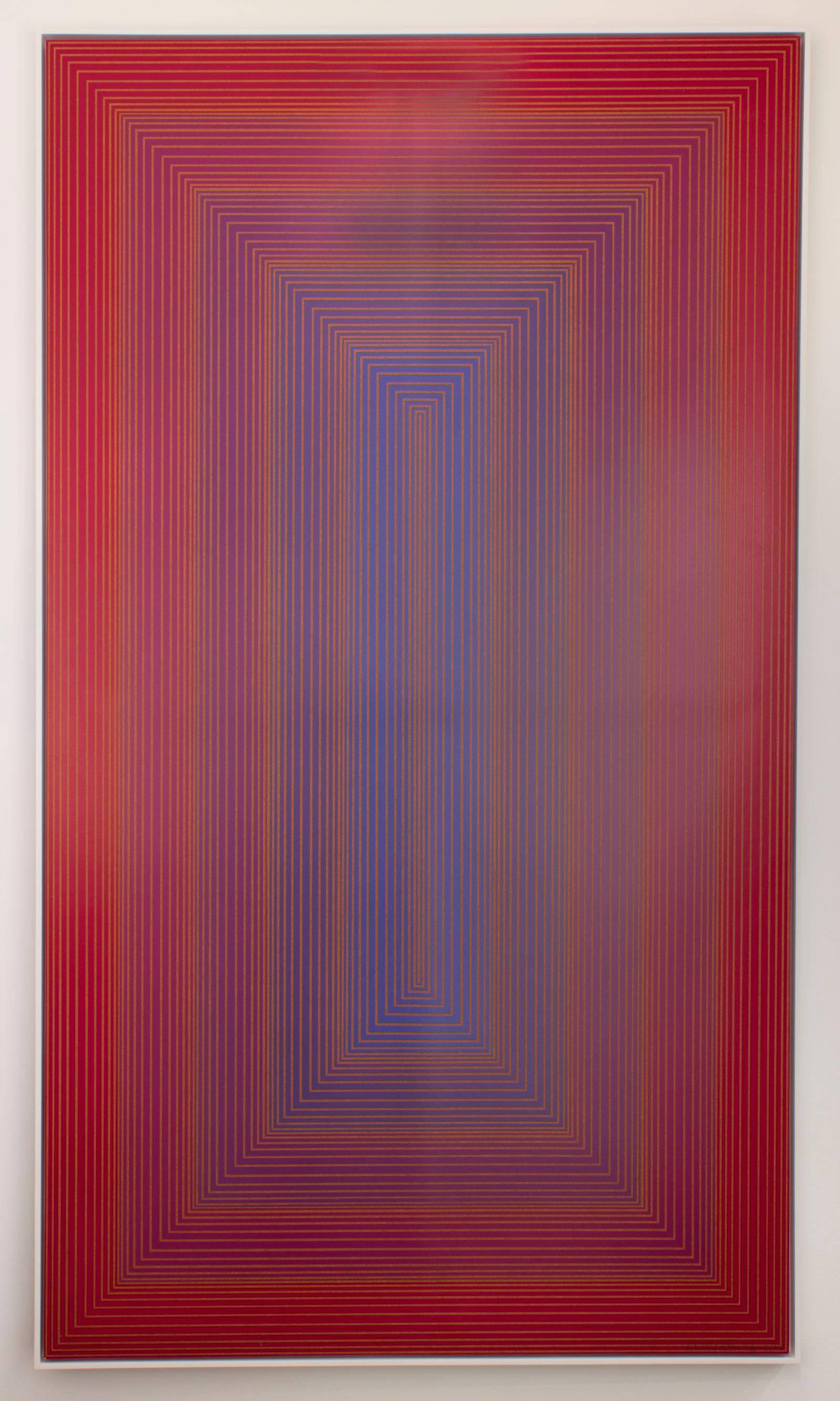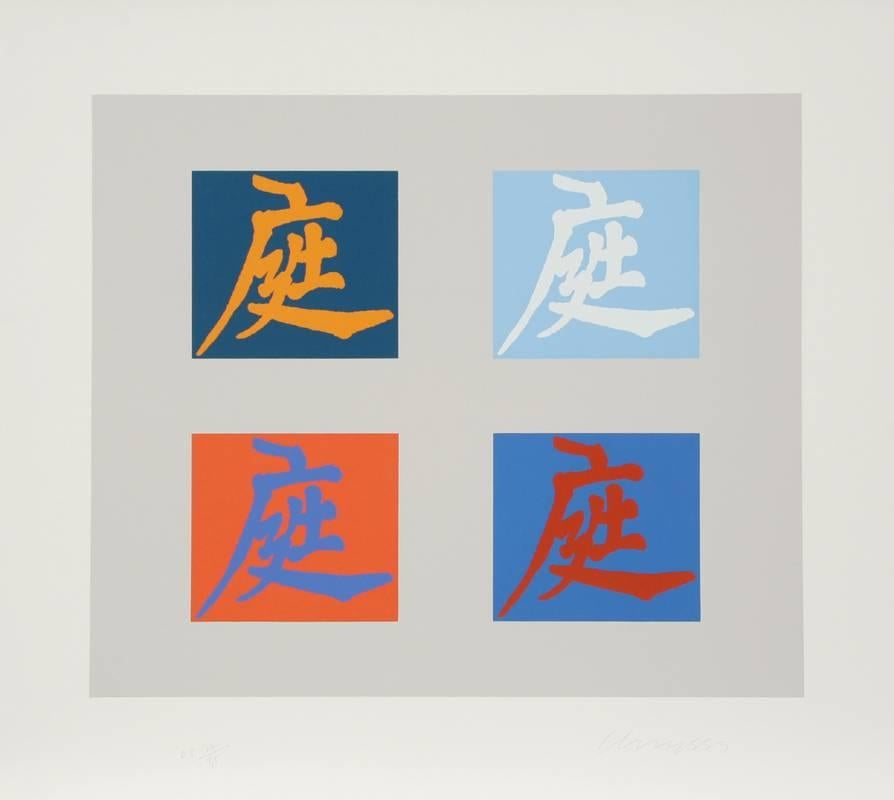Items Similar to Yellow Spike - British 60's Abstract art blue red grey COBRA Scottish artist
Want more images or videos?
Request additional images or videos from the seller
1 of 13
William GearYellow Spike - British 60's Abstract art blue red grey COBRA Scottish artist1962
1962
About the Item
An original silkscreen print by Scottish COBRA listed artist William Gear. An internationally famous abstract artist, Gear was a member of the COBRA group which was famous in the fifties and sixties for its abstract art. This trial proof 1/25 limited edition silkscreen is titled Yellow Spike and is typical of his work of the period. His prints are rare to market and his oils now command tens of thousands at auction and even higher at galley level. This is an exceptional example of a mid 20th century Scottish COBRA artwork. The colouring and condition are very good. It is a large size and signed with good provenance. Mid 20th century abstract artwork like this can be seen on display at Galleries and art fairs. This is a very good example of his work. A delightful painting.
Signed Gear '62 and titled Yellow Spike 1/25.
Provenance. PLC collection Scotland.
Condition. Large original silkscreen print. Image 27 inches by 16 inches and in very good condition. The colour is remarkable.
Housed in gallery frame which compliments the picture 40 by 28 inches, in very good condition.
William Gear (1915-1997). Few British painters have played an active role in the modern abstract movement of post-war Europe. William Gear was the most passionate and committed exception. He continued the tradition of the Edinburgh-Paris axis established by J.D. Fergusson, Samuel Peploe and others, spending vital years between 1947 and 1950 living and working in Paris. Significantly, in recent years, he received the greatest acclaim in France, Germany and the Netherlands. He was born in 1915 in Methil, Fife, into a mining family; the particular landscape of "pitheads, the sea, rocks, castles, trees, storms and poverty" marked his earliest identity with a place and probably remained the most influential to his art. Years later he recalled as a schoolboy visiting the local art gallery in Kirkcaldy and seeing 12 colourful still-lifes by Peploe. Art-history lessons during student years at Edinburgh College of Art, in particular Byzantine classes under David Talbot Rice, also influenced his concern for structure. This had as much to do with the formal language of painting as sheer delight in the medium itself. Gear never missed an opportunity to show people the merits of a well-constructed painting. On a travelling scholarship in 1937, he chose to study with Fernand Leger, described by Gear as "a keystone for me, seldom abstract, rather a degree of abstraction". The Second World War interrupted these formative years and, by 1940, Gear had joined the Royal Corps of Signals. Dispatched to the Middle East, he still had the discipline to paint - mostly works on paper of damaged landscapes - with exhibitions in Jerusalem, Tel Aviv, Cairo as well as Siena and Florence. His naturally robust and tenacious temperament was profoundly affected by visiting Bergen-Belsen, and this certainly influenced the later experiments with the black armature. As the British officer in Celle, working for the Monuments, Fine Arts and Archives Section of the Control Commission, he focused on securing the safety of the Berlin Art Collection in Schloss Celle, and organised an important series of modern art exhibitions, including the rejected work of Karl Otto Gotz. Only a few weeks before his death, this service to "democratic art and artistic freedom" was recognised in Hanover by a unique Leporello Award, appropriately instigated by fellow artists and presented by the Lower Saxony government. Demobbed in 1947, Gear headed for Paris, where he established a one-room studio at 13 Quai des Grands Augustins. This exciting period saw him gravitating towards what he called "the freer, dramatic approach of abstraction lyrique" rather then "the dogmatic hard-edged school of Mondrian and De Stijl". Within a year there were exhibitions at two of the pioneering salons and a first one-man show at the Galerie Arc en Ciel. At the same time inclusion in Cobra shows in Amsterdam and Copenhagen in 1949, alongside Constant, Corneille and Appel, underpinned his affiliation to a reinvigorated form of abstract expressionism. He worked at the time in the fluid medium of opaque water-colour, usually on card with pockets of intense colour on a white or neutral ground. While some pieces were purely abstract, others carried their own suggestion of landscape, or even a form of Celtic figuration. The same year saw an exhibition at the Betty Parsons Gallery in New York, alongside Jackson Pollock. The impact of American abstract expressionism however remained a sore subject, which in conversation was usually dismissed with a curt reminder of what he and others were already painting in Europe. The decision to return to England in 1950 was both personal and practical. Recently married to Charlotte Chertok, and with a baby, he had already secured in 1948 the first of a series of London exhibitions with the Gimpel Fils Gallery. The atmosphere surrounding the Festival of Britain also appeared to offer fresh opportunities. Notoriously, Gear was awarded one of the Festival of Britain Purchase Prizes for Autumn Landscape, a large oil on canvas which took six difficult months to complete. The event produced written questions and answers in the House of Commons and a tirade of abuse from the national press, not to mention a topic for debate on the radio programme Any Questions. While the episode made him a household name, the longer-term effects were, arguably, more detrimental. He chose not to live in London or join fellow abstract artists in St Ives, preferring the independence of a village in Kent between 1953 and 1958. This period saw the continued development of large landscape structures, as well as "side-roads" into sculptural subjects and minimalist colour paintings, which openly acknowledged the influence of Nicolas de Stael. These works have still to be properly exhibited. Mau-Mau (1953), for example, painted for the Contemporary Art Society but at the last minute withdrawn from display at the Tate Gallery, has its first London showing in the current golden jubilee exhibition at the Redfern Gallery. Gear was out of critical favour for most of the 1960s and 1970s. He exhibited more irregularly, despite returning to the use of dark structures broken by selected movements and light-inflected primary colours. While contemporaries questioned his move to Eastbourne as Curator of the Towner Art Gallery (1958-64), Gear's response was to take on the Purchase Committee. He changed the local authority's collection policy from Victorian and local views to securing the foundation of a major collection of post-war British art. His move to Birmingham came with the appointment as Head of the Faculty of Fine Art, Birmingham College of Art, in 1964, a post held until retirement in 1975, by which time he had become increasingly un- interested in the growing bureaucracy surrounding art education. His support and encouragement to artists living in Birmingham however continued with the purchases made for Birmingham Museums and Art Gallery on behalf of the Friends organisation (1987-94) as well as for his own personal collection. Most recently he instigated the idea of a gallery of modern art in Birmingham. Fortunately, the last 15 years have also gone some way to reverse the years of neglect. Gear and Stephen Gilbert (also Scottish) were the only British artists included in the major Cobra 1948-51 exhibition at the Musee d'Art Moderne, Paris, in 1982. The Cobra enthusiast Karel van Stuijvenberg has been a prominent patron and, in 1995, Gear took delight in attending the opening of the Cobra Museum of Modern Art in Amstelveen, near Amsterdam. He was equally proud of his long overdue election to the Royal Academy in 1995, and in the last years relished working with the fluidity and strong colours of oil stick. Tessa Sidey. Exhibited and held by worldwide galleries including The Tate.
- Creator:William Gear (1915-1997, Scottish)
- Creation Year:1962
- Dimensions:Height: 40 in (101.6 cm)Width: 28 in (71.12 cm)Depth: 2 in (5.08 cm)
- Medium:
- Movement & Style:
- Period:
- Condition:
- Gallery Location:London, GB
- Reference Number:1stDibs: LU85319124002
About the Seller
5.0
Platinum Seller
These expertly vetted sellers are 1stDibs' most experienced sellers and are rated highest by our customers.
1stDibs seller since 2018
398 sales on 1stDibs
Typical response time: <1 hour
More From This SellerView All
- Yellow Spike - British 60's Abstract art blue red grey COBRA Scottish artistBy William GearLocated in London, GBAn original silkscreen print by Scottish COBRA listed artist William Gear. An internationally famous abstract artist, Gear was a member of the COBRA group which was famous in the fif...Category
20th Century Abstract Abstract Prints
MaterialsScreen
- Abstract Landscape Red Green - Scottish Abstract Expressionist art oil paintingBy William GearLocated in London, GBThis stunning Scottish Abstract Expressionist oil painting is by noted Scottish artist William Gear. Painted in 1949 it is an early and significant painting which dates to the early part of his career. Entitled Abstract Landscape with Red and Green it was painted during Gear's time in Paris and involvement with COBRA. Mostly red and green shapes are incased in black on a vivid yellow background. A really pleasing composition to the eye and perfectly housed in an ebonised frame, it is an excellent example of Gear's work. Signed and Dated '49 lower right. Inscribed, titled and dated verso. Provenance: Cornish collection. Condition. Acrylic on canvas 25 inches by 20 inches and in good condition. Frame. Housed in an ebonised frame, 30 inches by 25 inches and in good condition. Few British painters have played an active role in the modern abstract movement of post-war Europe. William Gear was the most passionate and committed exception. He continued the tradition of the Edinburgh-Paris axis established by J.D. Fergusson, Samuel Peploe and others, spending vital years between 1947 and 1950 living and working in Paris. Significantly, in recent years, he received the greatest acclaim in France, Germany and the Netherlands. He was born in 1915 in Methil, Fife, into a mining family; the particular landscape of "pitheads, the sea, rocks, castles, trees, storms and poverty" marked his earliest identity with a place and probably remained the most influential to his art. Years later he recalled as a schoolboy visiting the local art gallery in Kirkcaldy and seeing 12 colourful still-lifes by Peploe. Art-history lessons during student years at Edinburgh College of Art, in particular Byzantine classes under David Talbot Rice, also influenced his concern for structure. This had as much to do with the formal language of painting as sheer delight in the medium itself. Gear never missed an opportunity to show people the merits of a well-constructed painting. On a travelling scholarship in 1937, he chose to study with Fernand Leger, described by Gear as "a keystone for me, seldom abstract, rather a degree of abstraction". The Second World War interrupted these formative years and, by 1940, Gear had joined the Royal Corps of Signals. Dispatched to the Middle East, he still had the discipline to paint - mostly works on paper of damaged landscapes - with exhibitions in Jerusalem, Tel Aviv, Cairo as well as Siena and Florence. His naturally robust and tenacious temperament was profoundly affected by visiting Bergen-Belsen, and this certainly influenced the later experiments with the black armature. As the British officer in Celle, working for the Monuments, Fine Arts and Archives Section of the Control Commission, he focused on securing the safety of the Berlin Art Collection in Schloss Celle, and organised an important series of modern art exhibitions, including the rejected work of Karl Otto Gotz...Category
1940s Abstract Expressionist Abstract Paintings
MaterialsOil
- Red Abstract, London 1955 - British Abstract Expressionist art oil paintingLocated in London, GBThis superb British Abstract Expressionist oil painting on board is by noted artist Bernard Kay. It was painted in London in 1955. This striking painting is a mix of shades of black ...Category
1950s Abstract Expressionist Abstract Paintings
MaterialsOil
- Scottish 1949 Abstract - Interieur Forme Blanche - CoBrA art oil paintingBy William GearLocated in London, GBThis stunning Scottish Abstract oil painting is by much noted artist William Gear. It was painted in 1949, not long after Gear de mobbed in 1947, moved to Paris and established a one room studio at 13 Quai des Grands Augustins, hence the title Interieur, Forme Blanche. At the same time, Gear was introduced to CoBrA, allowing him to exhibit in important early CoBrA shows in Copenhagen and in Amsterdam in 1949. The same year saw an exhibition at the Betty Parsons Gallery in New York, alongside Jackson Pollock. Gear remained in Paris until the early fifties. This bold abstract mixes blocks of solid colour with more geometric lines and is an excellent and important example of his period in Paris. Signed and dated '49 lower left. Provenance: Private London collection. Condition. Oil on canvas, 24 inches by 20 inches and in good condition. Frame. Housed in a wooded white painted frame, 34 inches by 30 inches and in good condition. Few British painters have played an active role in the modern abstract movement of post-war Europe. William Gear was the most passionate and committed exception. He continued the tradition of the Edinburgh-Paris axis established by J.D. Fergusson, Samuel Peploe and others, spending vital years between 1947 and 1950 living and working in Paris. Significantly, in recent years, he received the greatest acclaim in France, Germany and the Netherlands. He was born in 1915 in Methil, Fife, into a mining family; the particular landscape of "pitheads, the sea, rocks, castles, trees, storms and poverty" marked his earliest identity with a place and probably remained the most influential to his art. Years later he recalled as a schoolboy visiting the local art gallery in Kirkcaldy and seeing 12 colourful still-lifes by Peploe. Art-history lessons during student years at Edinburgh College of Art, in particular Byzantine classes under David Talbot Rice, also influenced his concern for structure. This had as much to do with the formal language of painting as sheer delight in the medium itself. Gear never missed an opportunity to show people the merits of a well-constructed painting. On a travelling scholarship in 1937, he chose to study with Fernand Leger, described by Gear as "a keystone for me, seldom abstract, rather a degree of abstraction". The Second World War interrupted these formative years and, by 1940, Gear had joined the Royal Corps of Signals. Dispatched to the Middle East, he still had the discipline to paint - mostly works on paper of damaged landscapes - with exhibitions in Jerusalem, Tel Aviv, Cairo as well as Siena and Florence. His naturally robust and tenacious temperament was profoundly affected by visiting Bergen-Belsen, and this certainly influenced the later experiments with the black armature. As the British officer in Celle, working for the Monuments, Fine Arts and Archives Section of the Control Commission, he focused on securing the safety of the Berlin Art Collection in Schloss Celle, and organised an important series of modern art exhibitions, including the rejected work of Karl Otto Gotz...Category
1940s Abstract Abstract Paintings
MaterialsOil
- City of Dreams - British Abstract art oil painting cityscape mapping red blackBy StanzaLocated in London, GBThis stunning large abstract oil on canvas oil painting entitled City of Dreams is by London based artist Stanza. Based on his interested in landscape, cities and surveillance this p...Category
21st Century and Contemporary Abstract Abstract Paintings
MaterialsCanvas, Oil
- A Guide to the Past - British Abstract art oil painting cityscape mapping blackBy StanzaLocated in London, GBThis stunning large abstract oil on canvas oil painting entitled A Guide to the Past is by London-based artist Stanza. Based on his interest in landscape, cities and surveillance thi...Category
21st Century and Contemporary Abstract Abstract Paintings
MaterialsOil
You May Also Like
- Nebula 1 - Contemporary print, Abstraction, Acrylic on paperLocated in Warsaw, PLMARIANNA STUHR Graduated from Faculty of Graphic Art at Academy of Fine Arts in Cracow as well as doctoral studies at Academy of Fine Arts in Warsaw. For a few years, she works in fi...Category
2010s Abstract Mixed Media
MaterialsPaper, Acrylic, Screen
- Times Square Remembered 2, Abstract Lithograph and Screenprint by Richard SmithBy Richard SmithLocated in Long Island City, NYArtist: Richard Smith, British (1931 - 2016) Title: Times Square Remembered 2 Year: 1973 Medium: Lithograph, Silkscreen and Collage, Signed and numbered in pencil Edition: 42 Si...Category
1970s Abstract Expressionist Abstract Prints
MaterialsMixed Media, Lithograph, Screen
- Bonac IIBy Larry ZoxLocated in Long Island City, NYArtist: Larry Zox Title: Bonac II Year: 1981 Medium: Serigraph, Signed and numbered in Pencil Edition: 160 Image Size: 36 x 17 inches Size: 42.5 in. x 30 in. (107.95 cm x 76.2 cm)Category
1980s Abstract Expressionist Abstract Prints
MaterialsScreen
- Times Square Fragment #9By Chryssa Vardea-MavromichaliLocated in Long Island City, NYArtist: Chryssa, Greek (1933 - 2013) Title: Times Square Fragment #9 Year: 1979 Medium: Serigraph, signed and numbered in pencil Edition: 300; AP 35 Paper Size: 38 x 25 inchesCategory
1970s Abstract Geometric Abstract Prints
MaterialsScreen
- Red to Blue PortalBy Richard AnuszkiewiczLocated in New York, NYRICHARD ANUSZKIEWICZ Red to Blue Portal, 1977 Screenprint on masonite 83 1/2 x 47 3/4 inches Edition of 50Category
1970s Abstract Geometric Abstract Prints
MaterialsMasonite, Screen
- "Tranquility #5, " Serigraph, 1979, Pop Art Screenprint by ChryssaBy Chryssa Vardea-MavromichaliLocated in Long Island City, NYThis serigraph was created by Greek artist Chryssa. An American art pioneer in light art and luminist sculpture widely known for her neon, steel, and acrylic glass installations, Chr...Category
1970s Abstract Geometric Abstract Prints
MaterialsScreen




